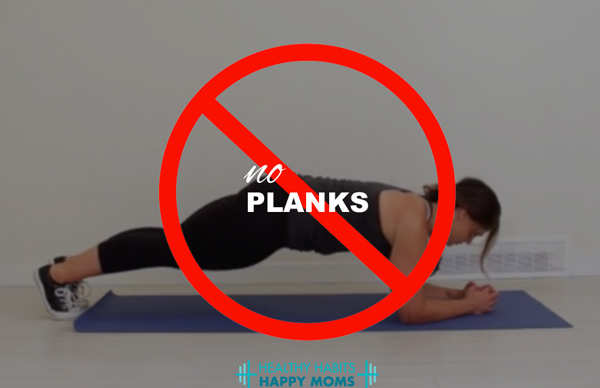After a baby is born what’s on many women’s minds is weight loss and returning their stomachs to pre-pregnancy form with core exercises.
What I WISH was on every woman’s minds was rest, recovery and rebuilding a strong and stable core. I’m not talking about washboard abs, I’m talking about the kind of core that is strong, stable, and supports your body in function, movement and exercise.
I completely understand wanting to feel “normal” again after sharing your body with a baby for nine months. However I see so many women with postpartum health issues that have returned to exercise too soon after childbirth or they have chosen core exercises that were harmful for their bodies in it’s postpartum state.
Two issues that are prevalent among postpartum women are diastasis recti and pelvic floor dysfunction (leaking, pain, pelvic floor muscle weakness). Luckily, there’s a lot we can do with exercise to prevent these issues! (I will get to that in the next few blog posts!)
Unfortunately many of the core exercises women choose to do after childbirth are not helping them regain core strength but hindering it. Here is a list of core exercises that should be avoided in the postpartum period (and pregnancy for that matter!):
1. Sit-Ups and Crunches
Sit-ups and crunches continue to be many people’s go-to exercises for strong cores. However, they also ignore that your core is made up of many muscles including the transverse abdominis, the multifidus, and – wait for it… The pelvic floor muscles! Surprise!! We can’t just focus on the abdominal muscles in our pursuit of strong cores.
During pregnancy women’s bellies expand and the result of that is stretched abdominal muscles and weakened/stretched connective tissue that connects those muscles (called the linea alba). Diastasis recti is something almost every woman will have by her third trimester. After pregnancy you need to give the body time to adjust to NOT carrying a baby! We want those abdominal muscles to come back together and the connective tissue that joins them to be strong and taut as it was prior to pregnancy.
Related: Diastasis Recti Test
Crunches and sit-ups aren’t bad, they just don’t consider your whole core.
How Long Do I Need to Stop Crunching?
Ditch the crunches and sit-ups until you’ve recovered (reconnected with your core, regained strength and stability, and are free from diastasis recti and pelvic issues) and are at least a year postpartum. Relaxin is a hormone that is present in your body until about twelve months postpartum for breastfeeding Moms and four months postpartum for formula-feeding Moms. This hormone makes women slightly more susceptible to injury, and frankly there are just better exercises to support a strong core.
2. Planks
Planks are awesome! But only when done with good alignment and a functional core. The issue with new Moms is they often don’t have a functional core. In a plank position women may feel like their abdominal muscles won’t contract or that they are “bulging out.” If you’ve done a diastasis recti test and find that your abdominal connective tissue is still very lax, your body probably isn’t ready.
That doesn’t mean planks are off the table forever. Before doing a plank again, postpartum women need to work through reconnecting with their core system and strengthening it appropriately. You can get started on that in my twenty week postnatal series here.
Other plank-type exercises to be avoided: push-ups and burpees, or any other belly down position.
Related: Healthy Habit Happy Mom Postnatal Series
How Long Do I Need to Stop Planks?
Julie Wiebe, Women’s Health Physical Therapist, believes that planks can play a part in postpartum recovery. “I have found that for some women the pull of gravity actually helps them reconnect with the abs and make them work,” she says in a recent blog post about planking with a diastasis.
Before you start with a full plank you need to progress appropriately. I start my clients off with bird-dogs. We then move onto planks from the knees, incline planks, and finally a full front plank, increasing the time under tension slowly.
You’ll know you’re ready to progress when you feel that the fascia between your abdominals is becoming more dense. Learn how to assess yourself here.
Where to Go From Here
I’m not going to leave you hanging! In my next few blog posts we will look at some safe and effective ways to reconnect with your core after childbirth and how to strengthen it safely with core exercises! Join our mailing list below to be notified when this blog goes live!
